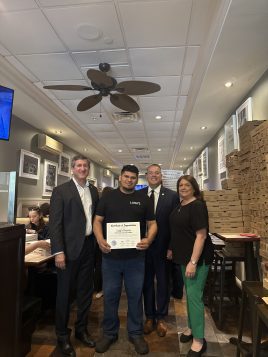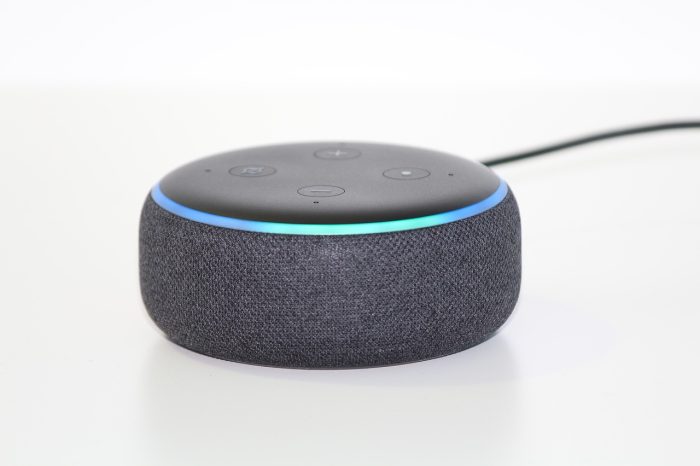Reviewed by Heidi Sutton
Through June 21, the fairest of them all and her seven friends will take up residence at Theatre Three in Port Jefferson for a musical retelling of Snow White and the Seven Dwarfs.
Written by Jeffrey Sanzel and Kevin F. Story with additional material by Jeffrey Hoffman and Douglas J. Quattrock, the show features all of the elements of the original Brothers Grimm fairy tale with the evil queen, the magic mirror, the seven dwarfs, the handsome prince, the poisoned apple and, of course, the enchanting Snow White.
Directed by Colleen Britt with choreography by Kiernan Urso, the show opens with the queen asking the Mirror for the umpteenth time who the fairest in the land is. When the Mirror replies Snow White, the queen summons Witch Yvonne to give her a makeover. When that goes horribly wrong, the jealous queen flies into a fit of rage and orders the Huntsman to take Snow White into the forest and dispose of her.
Of course the Huntsman doesn’t have the heart to do that so he lets her escape. Snow White comes upon the cottage of the seven dwarfs and the adventure begins.
Julia Rose Albino is perfectly cast as the sweet Snow White who infuriates the queen, played to the hilt by Cassidy Rose O’Brien, because she “is sooooo nice!” Indeed, every time Snow White enters the room you hear birds sing — a nice touch.
Although the names are different, the dwarfs — played by Louisa Bikowski, Ginger Dalton, Steven Uihlein, Sophia DelCarmen, Kaitlyn Jehle, Yashaun Harris, and Ryan Van Nostrand — have the same personalities of the original Doc, Grumpy, Happy, Sleepy, Bashful, Sneezy and Dopey. Special mention must be made of Bikowski as Iggy (aka Dopey) who can’t remember what happened three seconds ago, and Van Nostrand as Froggy (aka Doc) who has the patience of a saint.
Kyle Breitenbach is the handsome Prince who is on a quest to save a damsel in distress when he meets Snow White. The chemistry between Breitenbach and Albino is adorable to watch as they hide their identity from each other when they first meet, instead posing as Principal Marco Polo and Blanche Snowkowski.
The song and dance numbers, accompanied on keyboards by Douglas Quattrock and Jeffrey Hoffman, tie everything together. Albino’s rendition of “I Love It All” and O’Brien’s follow-up “I Hate It All” in the beginning of the show set up the storyline perfectly and Uihlein’s rendition of “I’ve Got Those ‘I’m-Just-a-Mirror-on-the-Wall’ Blues” is wonderfully executed.
Breitenbach and VanNostrand’s duet, “Someone,” shows off some dance skills and Breitenbach and Albino’s duet “I Think I’m in Like With You” is absolutely charming. “Hand in Hand” by the entire company is the perfect finale.
Costumes by Jason Allyn are colorful and fun and wait until you see the incredible special effects! This fairy tale production is not to be missed. Meet the entire cast in the lobby after the show for a group photo.
Theatre Three, 412 Main St., Port Jefferson presents Snow White and the Seven Dwarfs through June 21. All seats are $12
Children’s theater continues with The Fantasmix: A Superhero Journey Begins! from July 11 to July 26 with a sensory friendly performance on July 13 at 11 a.m.; and The Frog Prince from Aug. 1 to Aug. 9. All seats are $15.
For more information or to order, call 631-928-9100 or visit www.theatrethree.com.
——————————————–

PRINCESS TEA PARTY WITH SNOW WHITE!
Calling all little Princes and Princesses! Join Theatre Three, 412 Main St., Port Jefferson for a magical morning of fun at a Princess Tea Party with Snow White on Saturday, June 21 at Griswolds Cafe from 1 p.m. to 2 p.m. immediately following the closing performance of Snow White and the Seven Dwarfs! The royal event includes craft time, tea time with cookies from Curtain Call Confections, and a meet and greet with Snow White.
Tickets for the Princess Tea Party are $12. For more information or to order, call the box offie at 631-928-9100.

























